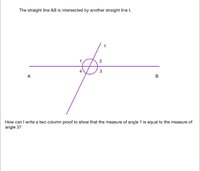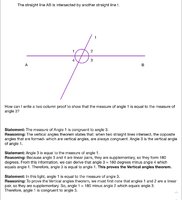The Velociraptors
New member
- Joined
- Jul 16, 2020
- Messages
- 48

I guess I am wondering how I could write a proof on this. I know about the vertical angles theorem, where vertical angles are always congruent. Also I know that angle 1 and 2 are supplementary because they form a linear pair. Angles 3 and 4 also form a linear pair, so they are supplementary. So would I write for the proof,
angle 1 is equal to angle 2 because they for a linear pair. Linear pairs are supplementary, so the must equal 180.
angle 4 and 3 also form a linear pair, so they must be supplementary.
I also know that angle 1= 180 - angle 2 which equals angle 3.
So angle 3 is equal to angle 1. This is what I’m thinking, but I don’t know if I am thinking correctly, or if this is even the correct way to write a proof.

